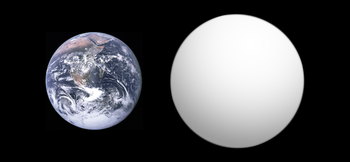Bumi super

Bumi super atau adibutala adalah planet luar surya dengan massa lebih tinggi dari Bumi, tetapi jauh di bawah raksasa es Tata Surya seperti Uranus dan Neptunus, yang masing-masing memiliki 14,5 dan 17 kali massa Bumi.[1] Istilah "Bumi super" hanya mengacu pada massa planet, dan tidak menyiratkan apa pun tentang kondisi permukaan atau kelaikhunian. Istilah alternatif "katai gas" mungkin lebih akurat untuk mereka yang berada di ujung skala massa yang lebih tinggi, meskipun " Neptunus mini" adalah istilah yang lebih umum.
Definisi
[sunting | sunting sumber]Secara umum, Bumi super ditentukan oleh massanya, dan istilah ini tidak menyiratkan suhu, komposisi, sifat orbit, kelaikhunian, atau lingkungan. Sementara beberapa sumber umumnya setuju dengan batas atas yaitu 10 kali massa Bumi[1][2][3] (~69% dari massa Uranus, yang merupakan planet raksasa Tata Surya dengan massa terkecil) dan batas bawah bervariasi dari 1 [1] atau 1,9 [3] hingga 5 kali massa Bumi[2] diikuti oleh berbagai definisi lain yang muncul di media populer.[4][5][6] Istilah "Bumi super" juga digunakan oleh para astronom untuk merujuk pada planet yang lebih besar dari planet mirip Bumi (dari 0,8 hingga 1,2 jari-jari Bumi), tetapi lebih kecil dari Neptunus mini (dari 2 hingga 4 jari-jari Bumi).[7][8] Definisi ini dibuat oleh operator teleskop luar angkasa Kepler.[9] Beberapa penulis lebih lanjut menyarankan bahwa istilah Bumi super mungkin terbatas pada planet berbatu tanpa atmosfer yang signifikan, atau planet yang tidak hanya memiliki atmosfer tetapi juga permukaan padat atau lautan dengan batas yang tajam antara cairan dan atmosfer, yang tidak dimiliki oleh keempat planet raksasa Tata Surya.[10] Planet di atas 10 kali massa Bumi disebut planet padat masif,[11] mega-Bumi,[12][13] atau planet raksasa gas,[14] bergantung pada apakah mereka terdiri atas sebagian besar batu dan es atau sebagian besar gas.
Referensi
[sunting | sunting sumber]- ^ a b c Valencia, V.; Sasselov, D. D.; O'Connell, R. J. (2007). "Radius and structure models of the first super-earth planet". The Astrophysical Journal. 656 (1): 545–551. arXiv:astro-ph/0610122
 . Bibcode:2007ApJ...656..545V. doi:10.1086/509800.
. Bibcode:2007ApJ...656..545V. doi:10.1086/509800.
- ^ a b Fortney, J. J.; Marley, M. S.; Barnes, J. W. (2007). "Planetary Radii across Five Orders of Magnitude in Mass and Stellar Insolation: Application to Transits". The Astrophysical Journal. 659 (2): 1661–1672. arXiv:astro-ph/0612671
 . Bibcode:2007ApJ...659.1661F. doi:10.1086/512120.
. Bibcode:2007ApJ...659.1661F. doi:10.1086/512120.
- ^ a b Charbonneau, D.; et al. (2009). "A super-Earth transiting a nearby low-mass star". Nature. 462 (7275): 891–894. arXiv:0912.3229
 . Bibcode:2009Natur.462..891C. doi:10.1038/nature08679. PMID 20016595.
. Bibcode:2009Natur.462..891C. doi:10.1038/nature08679. PMID 20016595.
- ^ Spotts, P. N. (28 April 2007). "Canada's orbiting telescope tracks mystery 'super Earth'". The Hamilton Spectator. Diarsipkan dari versi asli tanggal 2015-11-06.
- ^ "Life could survive longer on a super-Earth". New Scientist (2629). 11 November 2007.
- ^ "A team of ICE/IEEC astronomers announces the discovery of a possible terrestrial-type exoplanet orbiting a star in the constellation of Leo". Institut de Ciències de l'Espai. 10 April 2008. Diarsipkan dari versi asli tanggal 1 March 2012. Diakses tanggal 2012-04-28.
- ^ Fressin, François; et al. (2013). "The false positive rate of Kepler and the occurrence of planets". Astrophysical Journal. 766 (2): 81. arXiv:1301.0842
 . Bibcode:2013ApJ...766...81F. doi:10.1088/0004-637X/766/2/81.
. Bibcode:2013ApJ...766...81F. doi:10.1088/0004-637X/766/2/81.
- ^ Fulton, Benjamin J.; et al. (2017). "The California-Kepler Survey. III. A Gap in the Radius Distribution of Small Planets". The Astronomical Journal. 154 (3): 109. arXiv:1703.10375
 . Bibcode:2017AJ....154..109F. doi:10.3847/1538-3881/aa80eb.
. Bibcode:2017AJ....154..109F. doi:10.3847/1538-3881/aa80eb.
- ^ Borucki, William J.; et al. (2011). "Characteristics of planetary candidates observed by Kepler, II: Analysis of the first four months of data". The Astrophysical Journal. 736 (1): 19. arXiv:1102.0541
 . Bibcode:2011ApJ...736...19B. doi:10.1088/0004-637X/736/1/19.
. Bibcode:2011ApJ...736...19B. doi:10.1088/0004-637X/736/1/19.
- ^ Seager, S.; Kuchner, M.; Hier-Majumder, C. A.; Militzer, B. (2007). "Mass–radius relationships for solid exoplanets". The Astrophysical Journal. 669 (2): 1279–1297. arXiv:0707.2895
 . Bibcode:2007ApJ...669.1279S. doi:10.1086/521346.
. Bibcode:2007ApJ...669.1279S. doi:10.1086/521346.
- ^ Seager, S. (2007). "Mass‐Radius Relationships for Solid Exoplanets". The Astrophysical Journal. 669 (2): 1279–1297. arXiv:0707.2895
 . Bibcode:2007ApJ...669.1279S. doi:10.1086/521346.
. Bibcode:2007ApJ...669.1279S. doi:10.1086/521346.
- ^ Astronomers find a new type of planet: The 'mega-Earth'
- ^ Dimitar Sasselov (2 June 2014). "Exoplanets: From Exhilarating to Exasperating, 22:59, Kepler-10c: The 'Mega-Earth'". YouTube
- ^ Mayor, M.; Pepe, F.; Lovis, C.; Oueloz, D.; Udry, S. (2008). "The quest for very low-mass planets". Dalam Livio, M.; Sahu, K.; Valenti, J. A Decade of Extrasolar Planets around Normal Stars. Cambridge University Press. ISBN 978-0521897846.

